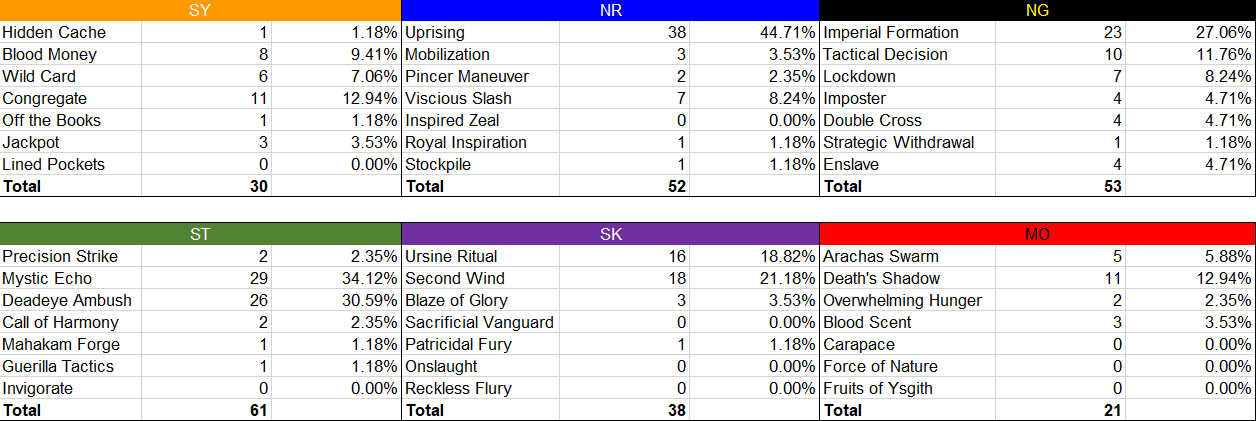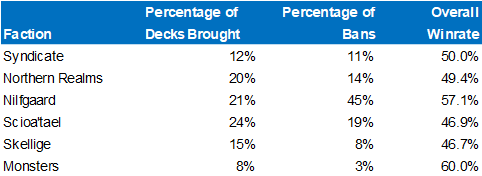
By Kochua, May 11, 2020

This weekend, Team Aretuza hosted open qualifiers for the Spring Team Clash. Many organized teams and community teams showed up to try and fight their way through the bracket and earn a spot in this week’s group stage.
In this article, we’ll provide a brief recap of the format, results, some deck stats, and some of our favorite decklists from the tournament.

Spring Team Clash - Qualifier Recap and Decklist Statistics
Format
The format for the qualifiers was as follows:
Results
A total of 24 teams signed up for the qualifier. After battling through several rounds of single-elimination, we were left with the following eight-team double elimination final bracket, which featured many prominent up-and-coming Gwent teams such as Team Bandit Gang and Team Elder Blood, as well as some more familiar names such as the prominent tournament organizers Claymore and the Italian team ESC Card Gaming.

In the end, the rosters for the two successful qualifying teams were:
- SLG Team: Champions of the winners bracket; comprised of Ignifriend, Ethree, Cilach28, and P_star.
- Claymore: Champions of the losers bracket; comprised of Wonder98, MagWTF, and MrSweetPiggy
Stay tuned this week for more information on these teams and their talented players, as they move on to face the biggest teams in Gwent for a chance at the Team Clash title!
Deck Statistics
Leader Selections
The qualifier took place only a few days after Gwent’s latest balance patch…so what deck archetypes did players choose to bring to the Best-of-3 Conquest format?

Three factions stood above the rest: Scoia’tael, Nilfgaard, and Northern Realms. Syndicate, which had been the most popular tournament faction last month and was so strong that it was almost always banned, has fallen way off the pace with the new patch. Monsters, as usual for the past several months, was the least frequently played faction.
We can also look at this in a different way, seeing what leader abilities proved to be most popular overall:

We see decent faction diversity, with all six factions having at least one leader that was brought relatively frequently.
More conclusions from the decklist statistics:
- Everyone, get in here! - 33 out of the 42 total leader abilities were brought at least once to the tournament.
- Prepare for the Uprising - Uprising was the most popular leader ability overall even after its recent nerf, appearing in 44.7% of lineups. However, Northern Realms was only the third most popular faction overall.
- Are you a Dryad Person, or an Elf Person? - Harmony decks (Mystic Echo) and Elf decks (Deadeye Ambush) seem to be rising towards the top of the meta again, several months after their last set of nerfs.
- Learn from the Best - Among players on the top 8 teams, the three most popular leader abilities were Uprising, Mystic Echo, and Imperial Formation.
Leader Bans and Win Rates
There are more ways to analyze deck strength than just looking at how frequently they were brought. We also collected ban and winrate statistics throughout the tournament to give a better picture of what archetypes seemed to carry their players to success, and which ones tended to come up short. We show a summary of these statistics in the following table:

We can also review this summarized by faction:

Here are some key conclusions
- Nilfgaard scum must die die die! - Nilfgaard was by far the most banned faction in the tournament, with Imperial Formation getting banned almost twice as much as any other leader ability.
- Balanced, as all things should be – Most factions had reasonably close to a 50% winrate. Monsters had the highest winrate, but also the lowest sample size.
- No Elder Bears? No Problem – Justifying the high ban rate, Imperial Formation boasted a strong 65% winrate when it was allowed be played, despite the month-old nerfs to Damien de la Tour and Stefan Skellen. A Masquerade Ball version of the deck seems to be popular these days…and based on this tournament, it seems to be successful as well.
Decks of the Tournament
Here, we feature two decklists that we found to be both interesting and competitive.
Magpie's Ursine Ritual
Gwent World Masters participant and Challenger champion Magpie131 brought an Ursine Ritual list featuring Lippy Gudmund to the tournament. Magpie was seemingly undeterred by the recent one-provision nerf to Cerys an Craite, and it still offers a very powerful tempo and thinning play when combed with the leader. If you add Lippy into the picture, the question becomes: Cerys is so much fun to play the first time, why not do it again?
IgniFriend's Uprising
IgniFriend, a competitive Pro Rank player and captain of qualifying Team SLG, brought an Uprising list that featured a tech against lists that “go wide” and flood the board. In addition to running a copy of Lacerate, Ignifriend also brought Triss: Telekinesis in order to be able to play a second copy of Lacerate (or a second copy of Northern Wind, if necessary). This deck also has good removal for an opponent’s tall units in the form of Bloody Baron, Prince Anséis, and occasionally Philippa: Blind Fury.
But in addition to this removal package, IgniFriend also included some of the usual NR engine package such as Queen Adalia, Anna Strenger and Temerian Drummer. The result is a deck that has a little bit of everything, and was able to help carry Team SLG to the group stage.
Conclusion
We hope that you enjoyed learning more about the popular and successful decks from this weekend’s qualifier. Stay tuned for the upcoming Group Stage, as the meta continues to evolve and we see who makes a strong bid to be called the best team in Gwent!

Author
Kochua
An actuary by day, unrepentant roper by night, and the Gwent Wild Hunt #2 LAN Champion, Kochua brings a highly quantitative and analytical approach to competitive games. He discovered Gwent in October 2017 and was an instant convert, won over by the game's complexity and depth of strategy. During 2018, he compiled several top-50 Pro Ladder finishes in addition to winning Wild Hunt #2. In 2019, Kochua took a brief detour into Magic the Gathering: Arena, earning a bid in a Mythic Championship Qualifier Weekend before finally making the move to Dota Underlords. Kochua provides the team with editorial support, with a goal of making Aretuza the leading source of competitive Gwent and Underlords content. He also helps the team in its constant search for an analytical edge, and in the meantime tries some of his crazier theories out on the Underlords ladder as a Lord of White Spire.



